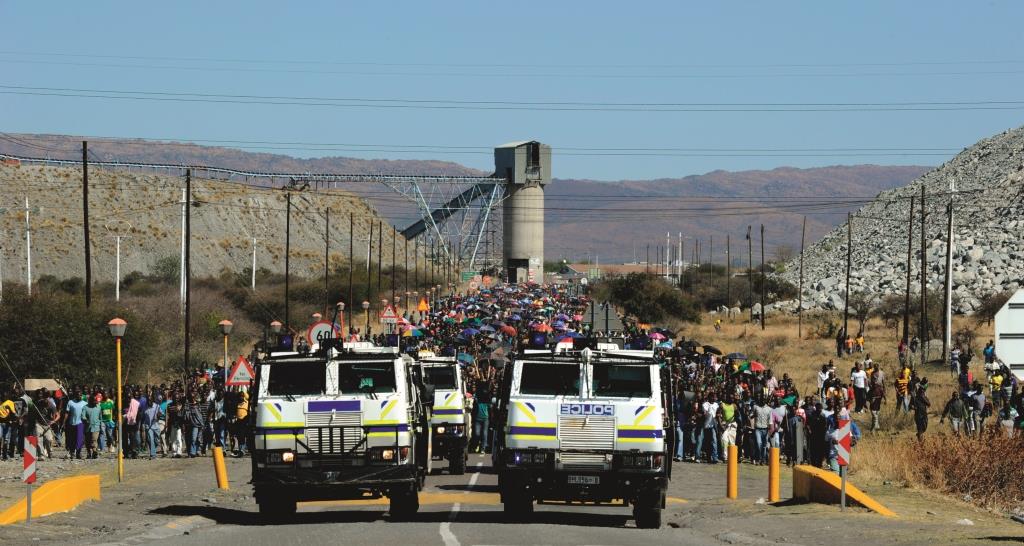South African mining is in tatters after weeks of spreading violence and chaos that has cost R4.5 billion ($544 million) in lost production and threatened many of the country’s erstwhile prosperous mines.
More than 1,000 soldiers have been posted to Marikana and a tight police cordon thrown around the operation.The Lonmin strike has seen one shaft mothballed and 1,200 contract workers sacked.
This is the bitter aftermath of the shootings at the Marikana operations of Lonmin, near Rustenburg north west of Johannesburg, in which 45 people were killed. In the weeks that followed, the wildcat strikes and wage demands spread. It is a sign of dangerous times that Anglo American Platinum (Angloplats) decided to suspend its Rustenburg operations, on September 12, to protect its workers from intimidation—a blow to the international image of South African mining.
“Well, it has been hurt, it has been damaged. You can’t have such a serious incident during a democracy. We have to work towards making sure that we bring back the image and the sanity of the industry,” says Susan Shabangu, South Africa’s minister of mineral resources.
Then there were more wage demands at nearby Implats, strikers stopped workers going underground at Royal Bafokeng Platinum, there was a wildcat strike by 15,000 workers at Gold Fields in Carletonville, 79 kilometers west of Johannesburg; at Marikana 28,000 thousand workers refused to go back and marched with weapons as peace talks failed and wage offers were rejected. The workers want a minimum of R12,500-a-month—triple the current wage.
Loading...
The unions couldn’t call the workers back and the management appeared powerless to dismiss—often a swift way of squashing an illegal strike—for fear of even more unrest.
The biggest upshot of all this is the highly regulated labor relations procedures—which has helped keep the number of mine strikes down over the years—has been bypassed, at best, mocked at worst. In the past, under the eye of independent mediators, the Commission for Conciliation, Mediation and Arbitration, wage demands went through extensive talks and delicate mediation. Only an irrevocable breakdown would lead to a strike certificate and a legal walk out. Even then, at best there would be at most a day or two of posturing on the picket line, or even a last minute deal before a drill was downed.
“They are opening up the entire mining industry to pay demands and illegal strike action, you are not going to be able to control illegal strike action… My biggest fear is that we are not working towards a long term solution,” says the national spokesman of the National Union of Mineworkers (NUM), Lesiba Seshoka.
The first bitter legacy of Marikana is growing distrust and animosity between workers and management in an industry where the deeper underground you work, the less you get paid.
“Let’s be fair, when CEOs get millions we say nothing, when miners ask for twelve thousand Rand everybody make a noise. The manner the economy is structured doesn’t benefit everyone,” says the president of the Association of Mineworkers and Construction Union (AMCU), Joseph Mathunjwa, on August 31.
During question time in Parliament in Cape Town, on September 13, President Jacob Zuma blamed Lonmin for the unrest at Marikana saying the living conditions in the hostels left a lot to be desired and the company should have built family homes instead.
“Lonmin acknowledges that living conditions are not ideal but it is working towards better living conditions. We accept the criticism, but improving living conditions is a long process,” says Lonmin spokeswoman Sue Vey.
The second legacy of Marikana will be higher costs for mining companies, at a time when they can ill afford it, as workers appear to have proved they can ask for more wages when they want. In mining, most pay negotiations are run, in an orderly fashion, through the Chamber of Mines every two years. Gold and coal miners do this; there are proposals to bring platinum into these pay talks, but it may be too late.
Peter Major, a mining analyst with Cadiz Corporate Solutions, who has studied South African mining for more than 30 years, believes costs in platinum mining are likely to soar.
“Profit margins have fallen from 50%, a few years ago, to 10% now, quite simply the industry is running out of rope… We are getting to a point where people won’t be able to make money even at these platinum prices… It is terrifying, costs have been going up around 20% a year and these wage demands are likely to send these costs soaring even higher,” says Major.
In the angry chaos of South Africa’s mine, costs may prove the least of its problems.
Loading...
